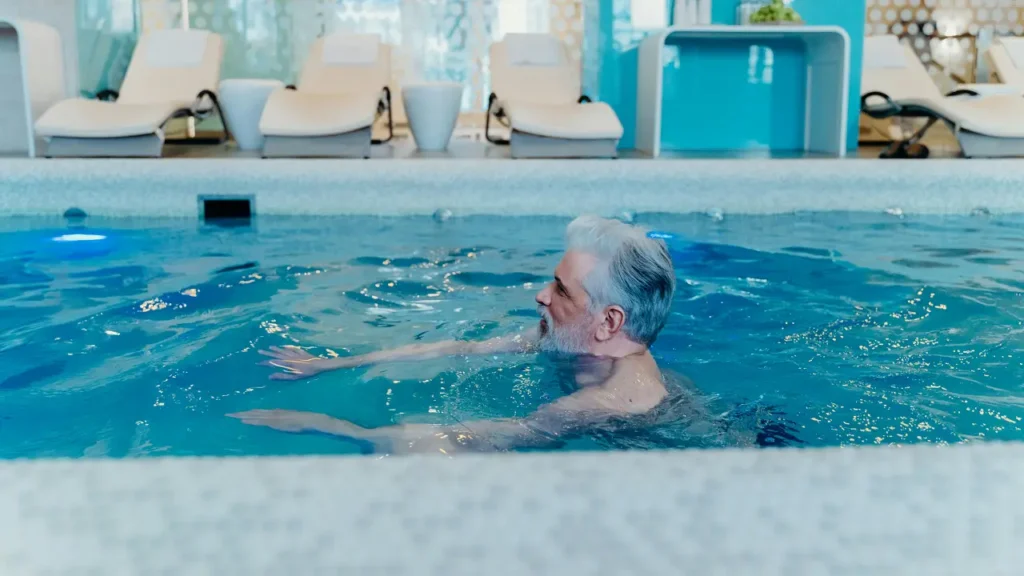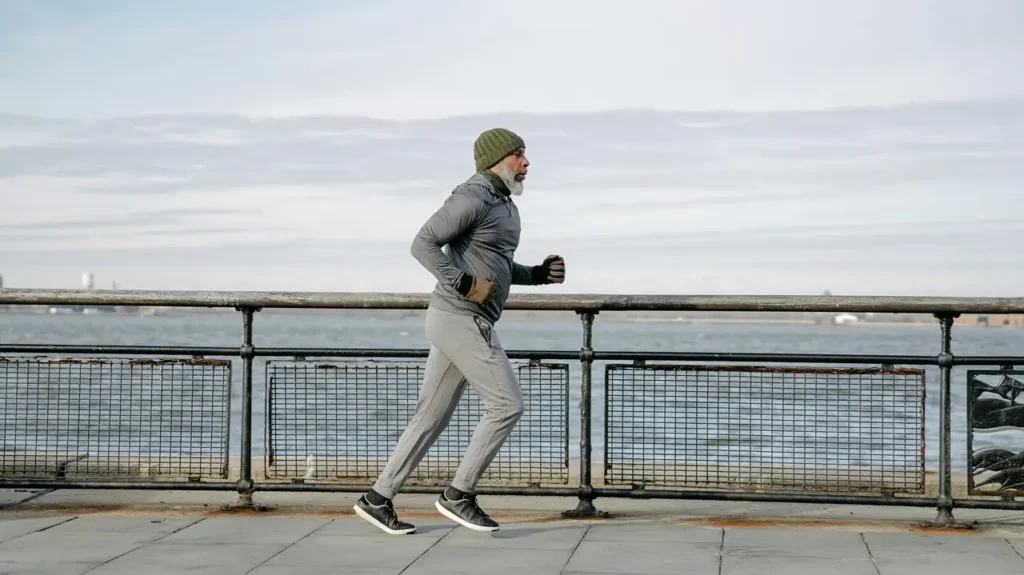Swimming is an excellent form of exercise for seniors. Swimming, in particular, is a low-impact, full-body workout. This exercise is gentle on the joints.
Below are some key benefits of swimming for seniors:
- Improves joint mobility
- Supports mental health
- Supports circulatory system
- Burns calory
- Enhances breathing system
- Promotes restful sleep
Why Swimming is Ideal for Seniors
High-impact exercises exacerbate body issues. It is difficult for seniors to stay active without risking harm with running, and weight-lifting. This is where swimming comes in as a low-impact
Swimming is a non-weight-bearing exercise. The water supports your body weight. Unlike activities such as walking or jogging, where your joints bear the full impact of your body weight, swimming allows you to move freely without placing undue stress on your joints.
When you’re submerged in water, your body feels lighter. Swimming helps alleviate pressure on the spine. The water’s buoyancy allows for gentle stretching and strengthening of the back muscles.
Swimming strengthens muscles and improves balance. The risk of falling is virtually eliminated in swimming. This makes it an ideal exercise for seniors who are at higher risk of falls due to age-related balance issues.
Swimming is often recommended as part of rehabilitation programs for seniors. The low-impact nature of swimming allows for gradual strengthening of muscles and joints without the risk of re-injury.
Running or jumping can lead to overuse injuries. Shin splints, stress fractures, and tendonitis are common in high impact exercises. These types of injuries are less likely to occur with swimming. The water provides resistance without the repetitive pounding. This wear down joints and connective tissues.
This makes swimming a sustainable form of exercise that seniors can continue well without worrying about overuse injuries.
Swimming Provides Improved Joint Mobility
Swimming requires a wide range of motion. You can swim freestyle, breaststroke, and backstroke. The resistance of water encourages controlled movements of your muscles. This helps improve joint flexibility and mobility.
Over time, seniors regain a greater range of motion in their joints. This motion helps performing daily activities like bending, reaching, and climbing stairs.
Regular swimming helps combat stiffness by promoting fluid movement in the joints. This is particularly beneficial for seniors who experience morning stiffness.
Water supports the body. Those with limited mobility on land find freedom of movement in the water. This inclusivity makes swimming an accessible option for seniors who may feel restricted by other forms of exercise.
Swimming Supports the Mental Health of Seniors
Being in water has an inherently calming effect on the mind. The buoyancy of water reduces the sensation of gravity, creating a feeling of weightlessness. This sensory experience helps seniors feel more at ease.
Swimming requires controlled, rhythmic breathing. This type of breathing activates the parasympathetic nervous system. The combination of physical movement, controlled breathing, and the calming properties of water makes swimming an effective tool for managing anxiety in seniors.
Swimming stimulates the release of endorphins. These “feel-good” hormones help combat feelings of depression. The repetitive, meditative nature of swimming further amplifies these effects.
Swimming also boosts the production of neurotransmitters- dopamine and serotonin. Low levels of these chemicals are linked to depression and anxiety.
Swimming is a full-body workout. The coordination required for different swimming strokes, combined with the need to regulate breathing, stimulates neural pathways and enhances cognitive function. These processes help maintain memory, attention, and problem-solving skills in seniors.
Swimming improves blood flow to the brain, reduces inflammation, and enhances the clearance of amyloid plaques, which are implicated in Alzheimer’s pathology.
How Swimming Benefits the Heart and Circulatory System
Swimming offers a wide range of cardiovascular benefits for seniors. Swimming strengthens the heart muscle and improves circulation. During swimming, the heart pumps more blood to deliver oxygen to the muscles. Regular swimming sessions lead to a stronger, resilient heart that can pump blood more effectively with less effort.
Swimming has been shown to help lower blood pressure by improving the elasticity of blood vessels and reducing arterial stiffness. Swimming helps reduce the risk of coronary artery disease, and heart attacks by improving cholesterol levels. The combination of aerobic activity and water immersion creates an optimal environment for cardiovascular health.
Each stroke in swimming requires coordinated muscle contractions, which help push blood back to the heart and improve venous return.
Poor circulation leads to the formation of blood clots. Blood clots can cause strokes, deep vein thrombosis (DVT), or pulmonary embolisms. Swimming helps prevent these issues by keeping blood flowing smoothly through the veins and arteries.
Swimming Burns Unnecessary Calorie
Seniors can’t burn calory properly. Swimming helps them to burn calories. This is an excellent exercise for them to lose weight. Depending on the intensity of the swim and the stroke used, swimming can burn between 400-700 calories per hour.
Swimming engages multiple muscle groups simultaneously, including the arms, legs, core, and back. The resistance of water adds an extra challenge, requiring more energy expenditure than many land-based exercises. For example:
Freestyle (Front Crawl): Burns approximately 500-700 calories per hour.
Breaststroke: Burns around 400-600 calories per hour.
Backstroke: Burns about 400-500 calories per hour.
Metabolism naturally slows down with age. Regular swimming help boost metabolism. A faster metabolism means the body burns more calories. Swimming increases the body’s demand for oxygen, which in turn raises the metabolic rate. Over time, consistent swimming leads to an elevated resting metabolic rate (RMR).
Seniors who swim regularly report feeling energetic throughout the day. This improves their quality of life and encourage them to stay active.
Swimming Enhances Breathing Control

The unique demands of swimming significantly enhance lung capacity, strengthen respiratory muscles, and improve oxygenation of the body. These benefits are important for seniors.
Swimming requires hold breath during certain strokes and then exhale forcefully when in surface. This pattern of breath-holding and controlled exhalation helps expand lung capacity over time. This strengthens the diaphragm and intercostal muscles. As a result, the lungs become efficient at taking in and utilizing oxygen.
Swimming reduces the frequency and severity of asthma. The controlled breathing patterns used in swimming help train the body to breathe efficiently. This reduces hyperventilation or shortness of breath.
The rhythmic breathing patterns help control involuntary functions like heart rate and breathing. By practicing controlled breathing, seniors can reduce stress, lower their heart rate, and improve overall respiratory efficiency.
Swimming Promotes Restful Sleep for Seniors
Swimming helps regulate the circadian rhythm – the sleep cycle. Swimming increases body temperature. The subsequent drop in body temperature after swimming signals to the brain that it’s time to sleep. This natural cooling effect mimics the body’s natural sleep onset process.
Deep sleep is crucial for physical recovery, memory consolidation, and emotional regulation. Swimming promotes deeper sleep.
Many seniors experience frequent awakenings during the night. This causes fragmented sleep and daytime fatigue. Swimming helps reduce nighttime awakenings by promoting relaxation.
Swimming leads to physical fatigue that naturally promotes sleep. The combination of cardiovascular exercise and muscle engagement ensures that the body is ready for rest by the end of the day.
Tips for Seniors Starting Swimming
Before starting any new exercise program, seniors should consult with their healthcare provider.
Begin with short sessions and gradually increase the duration and intensity as your fitness improves.
Consider using swim goggles, a swim cap, and appropriate swimwear for comfort and safety.
Even though you’re in water, it’s important to stay hydrated before and after swimming.
Always warm up before swimming and cool down afterward to prevent muscle stiffness and injury.
Swimming is one of the most beneficial forms of exercise for seniors. It offers a comprehensive workout. It improves physical health, mental well-being, and overall quality of life. Its low-impact nature makes it accessible to people of all fitness levels, and its numerous health benefits make it an ideal activity for maintaining independence and vitality in later years.




